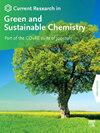Engineering stable Ti3+ defects in a titanium dioxide matrix by wet bead-milling: Visible-light assisted efficient photocatalytic hydrogen production from water
Q2 Materials Science
Current Research in Green and Sustainable Chemistry
Pub Date : 2024-01-01
DOI:10.1016/j.crgsc.2024.100423
引用次数: 0
Abstract
Solar-driven hydrogen production technologies are of increasing interest. In this work, Ti3+ was incorporated into titanium dioxide via wet bead-milling, resulting in enhanced photocatalytic activity under both UV and visible light irradiation. The broad optical absorption obtained from the presence of Ti3+ ranged from the visible to near-infrared regions of the spectrum (specifically from 400 to over 900 nm) and this absorption could be enhanced by increasing the diameter of the beads used for wet milling. The hydrogen production rate from water in response to ultraviolet (UV)-visible light with ethanol as a sacrificial reagent was also found to vary depending on the bead diameter. Producing the optimal level of Ti3+ incorporation in the titanium oxide matrix while maintaining a high specific surface area increased the extent of hydrogen production during water decomposition. A sample prepared using 0.3 mm diameter beads exhibited the highest hydrogen production rate of 145 μmol h−1 g−1, which was 15 times that obtained from commercially available anatase-type titanium dioxide having higher specific surface area. The hydrogen production rate under only UV light (<400 nm) was decreased to one-ninth of that obtained using both UV and visible light simultaneously. No hydrogen gas was generated in trials using only visible light (>410 nm). These results indicate that visible light significantly promoted the photocatalytic reaction when both UV and visible light were irradiated simultaneously.

用湿球磨法在二氧化钛基体中制造稳定的Ti3+缺陷:可见光辅助下的高效光催化水制氢
太阳能制氢技术越来越受到关注。在这项工作中,通过湿球磨将Ti3+掺入二氧化钛中,从而增强了紫外线和可见光照射下的光催化活性。从Ti3+的存在中获得的广泛的光学吸收范围从可见光到近红外光谱区域(特别是从400到900 nm以上),这种吸收可以通过增加用于湿磨的珠子的直径来增强。以乙醇作为牺牲试剂,水对紫外-可见光的反应产氢速率也随球头直径的变化而变化。在保持高比表面积的同时,在氧化钛基体中产生最佳水平的Ti3+,增加了水分解过程中产氢的程度。用直径0.3 mm的微球制备的样品产氢率最高,为145 μmol h−1 g−1,是市购锐钛矿型二氧化钛的15倍,具有较高的比表面积。仅在紫外光(<400 nm)下的产氢率降低到同时使用紫外光和可见光时的九分之一。在仅使用可见光(>410 nm)的试验中没有产生氢气。这些结果表明,可见光和紫外光同时照射对光催化反应有明显的促进作用。
本文章由计算机程序翻译,如有差异,请以英文原文为准。
求助全文
约1分钟内获得全文
求助全文
来源期刊

Current Research in Green and Sustainable Chemistry
Materials Science-Materials Chemistry
CiteScore
11.20
自引率
0.00%
发文量
116
审稿时长
78 days
 求助内容:
求助内容: 应助结果提醒方式:
应助结果提醒方式:


